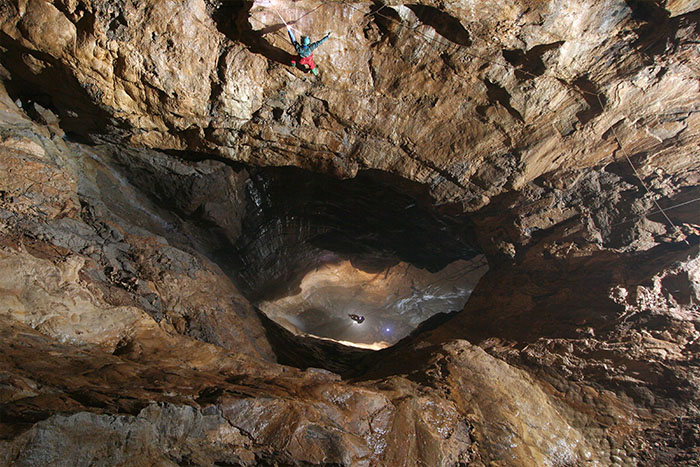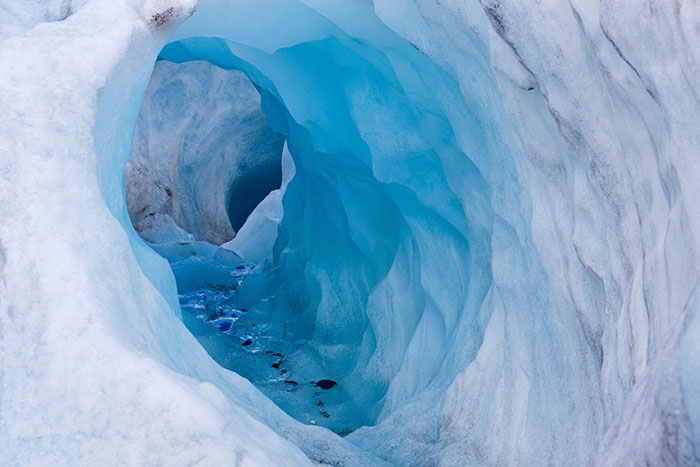News & Views
Underland: A Deep Time Journey
Barbara Vellacott appreciates Robert Macfarlane’s latest book

The Titan shaft in the Peak District is the deepest in the UK, descending 145 meters. Photograph: Robbie Stone/Alamy Stock Photo
This is the book of the summer for me. It is deeply memorable. ‘Deeply’ is of course the right word, for it is about exploration of places underneath – sometimes very, very deep underneath – the surface of the earth on which we daily plant our feet. The writer obeys a well-recognised and ancient human compulsion to explore the depths: of limestone caves in the Mendips; of salt and potash mines extending far under the Yorkshire dales and the North Sea; of the starless River Reka of Slovenia; of the miles-deep ice of Greenland, and more. Many of these places beneath the earth I had absolutely no idea even existed, and was astonished.
It is tempting to describe Macfarlane’s ventures as he explores these underground worlds, which call for stamina, suitable equipment, a reliable guide and courage – but you should read the book. Here I offer a few observations and images as enticements.
There are scenes of incredible beauty, like the varied blues of the different kinds of ice in the glaciers and mountains of Greenland. There are places that are profoundly mysterious, like the ‘Red Dancers’ at Lofoten, Norway. These are red, dancing human figures, 2,500 years old, in the cave named ‘Kollhellaren’ – Hole of Hell – in the uninhabited islands of the north-west of the country, to which the writer makes a solitary and hazardous journey in what is one of the most haunting episodes of the book.
Through these narratives, we have the fascination of knowing more about extraordinary places under the earth. But it is the psychological and mythic dimensions of the journey into the dark which exert the real hold of this book on the reader’s imagination. With regular references to the mythic or poetic journeys of heroes like Aeneas, Orpheus or Dante, Macfarlane holds together the physical, psychological and spiritual dimensions of human experience. There is a strength here, in that he does so by suggestion, and by interweaving these dimensions into his narrative, rather than by exposition.

A shaft in the ice sheet, called a ‘moulin’, caused by glacial meltwater. Photograph: Arndt Sven-Erik/Anterra Picture Library/Alamy Stock Photo
Deep Time
.
The subtitle to the book is ‘a deep time journey’, which is true in two senses. First, when descending into the earth, we necessarily travel into the past as we pass through strata of rock laid down over millennia, through caverns carved out over centuries, into places of ancient human activity, and we get a sense of the aeons of time behind our present ‘now’. But there is something more: the sense of time-less-ness that some explorers experience, which is akin to mystical experience. The writer presents us with a poem by Natalia Molchanova, a diver and a poet:
The silence of eternal dark,
And the infinity.
I went beyond the time,
Time poured into me
And we became
Immovable.
I lost my body in the waves
… Becoming like its blue abyss
And touching on the oceanic secret. (p.199)
He also quotes the British diver Don Shirley:
I have such beautiful moments in the water. You are absolutely, completely in a void, like being in outer space… You get to the point where there is no God, no past, no future, just now and the next millisecond. It’s not a threatening environment – just total serenity. (p.198)
What is it that compels some intrepid human beings to dive into deep underground lakes, caverns and long tunnels, and risk life to explore the dangers of the physical dark? With vivid images, Macfarlane gives a tingling sense of the mixture of fear and excitement, horror and beauty, terror and fascination with the dark unknown. He gives no answer to the question I ask, but, although few of us would choose experiences of crawling through narrow fissures, face pressed to the rock, or standing on a narrow ice bridge staring down into a bottomless crevasse, most of us probably recognise the feeling and compulsion because they echo an existential truth that we may face such things inwardly or in imagination.
When we venture into the depths – the unconscious – we will find fearsome things buried from the past, and they come back to haunt us when we start the exploration. The journey nevertheless yields treasures: knowledge, insight, things of beauty, creativity and wisdom.
As with the psychological and spiritual, so with the physical. Macfarlane’s journeys make it very clear – especially in later sections of the book – that human activity has polluted, and is still polluting, many underland places. We go on burying our waste, the most serious now being the need to dispose of nuclear fuel. He visits one such site, which he calls ‘The Hiding Place’ in Finland, where spent uranium is being stored in rock 1,500 feet down into the earth.
We live in a time which we might call ‘the dark night of the planet’, when we do not know what to do or where we are going. At the end of Underland there is a heartening picture of the endeavour of some far-sighted people to be ‘good ancestors’ by working hard to leave some message for our descendants, warning them of the dangers of uncovering what is deeply buried. They are even taking account of the irresistible human impulse to go precisely where we are warned not to go.
Who knows? These things are vast and imponderable! Let us play our part now and pray that future men and women will be wise enough to know where to go and how to treasure the earth.
Underland: A Deep Time Journey by Robert Macfarlane is published by Hamish Hamilton (London, 2019)
Barbara Vellacott
With a background in adult education and overseas development issues, Barbara Vellacott now teaches poetry. Particular interests are William Blake and the English Romantic poets. In recent years the study of Ibn ʿArabī has also been a great inspiration. She lives just outside Oxford, UK.
More News & Views
Don’t Take It Easy
Richard Gault is inspired by Michael Easter’s book The Comfort Crisis and explores the idea of ‘misogi’ during a 600-mile walk across Scotland
Book Review: ‘The Serviceberry’
Martha Cass contemplates the message of a new book by Robin Wall Kimmerer that advocates ‘an economy of gifts and abundance’
Book Review: ‘Conversations with Dostoevsky’
Andrew Watson engages with an innovative new book by George Pattison which explores Dostoevsky’s relevance in the contemporary world
Thich Nhat Hanh & the Poetry of Engaged Buddhism
Philip Brown presents the poem ‘Recommendation’ and comments on the potential of contemplative art to foster compassion
Introducing… ‘Perfect Days’ and ‘Nowhere Special’
Jane Clark watches two films with a contemplative theme
Book Review: ‘Irreducible: Consciousness, Life, Computers and Human Nature’
Richard Gault reviews a new book by Federico Faggin, one of the leading lights of the science of consciousness
FOLLOW AND LIKE US
——————————————
——————————————
——————————————
If you enjoyed reading this article
Please leave a comment below.
Please also consider making a donation to support the work of Beshara Magazine. The magazine relies entirely on voluntary support. Donations received through this website go towards editorial expenses, eg. image rights, travel expenses, and website maintenance and development costs.
READERS’ COMMENTS
2 Comments
Submit a Comment
FOLLOW AND LIKE US
Clear, informative, thoughtful, enthusiastic: an excellent review. I went and ordered the book immediately.
“Time, it is proven, is the sea
Whose artefacts are joined by separateness”
by Clive James from his autobiographical poems “The River in the Sky”